Do you have a 1 year old that’s constantly waking up at night for one or more feeds? It’s so hard, I know. And you are not alone!
Here’s all the information you need on how to stop breastfeeding a 1 year old at night, including tips on how to get your baby to sleep better so that they can start sleeping through the night.

My Own Experience with Breastfeeding at Night
I have been exclusively breastfeeding my second daughter from birth and I have absolutely loved it. But, I must say, by 12 months old I was exhausted with all the waking up and I was so ready to wean her off breastfeeding at night!
I used to think nighttime nursing was so easy, particularly compared to bottle feeding. I bottle fed my first daughter and I used to hate getting up all the time to prepare the bottle, turning the lights on, etc. By the time I went back to bed I was wide awake and it would take me forever to fall back to sleep.
Breastfeeding, on the other hand, required such little effort, particularly when co-sleeping. I just had to pull my top up and I could feed my baby in bed with all the lights off. It was then much easier to go back to sleep.
And, other than the 4 month sleep regression, when she was waking up every 2 hours, she was quite consistent with waking up just once or twice for a feed (also read our article on combination feeding with some alternatives to exclusively breastfeeding).
The problems started when she was 1 year old though. I was starting to feel quite exhausted with all the waking up in the middle of the night. Particularly because I had to go back to work and be on the road by 6.30 am!
Plus she started waking up more often and was getting quite upset if I wasn’t giving her the boob. She was still in our bedroom (in her own crib) and there was no way to re-settle her without a feed, or without putting her in bed with us. But, even then, she would toss and turn for almost 2 hours before falling asleep again.
Physiologically, babies may still need to feed at night until they are well established on solids, which is around 9 months old. We were way past that: it was time to drop those night feeds!
It took a couple of weeks, but my daughter is now 14 months old and sleeping through the night (7 pm to 7.30 am) without any feeding in between. She sometimes wakes up around 1 am or 4 am, but I can easily re-settle her without nursing her to sleep. Otherwise she sleeps through without any fuss.
I will share with you here how I manged to achieve that and how to stop comfort feeding at night so you can start having a better sleep! All without letting your child cry for hours (cry-it-out method) – something that I tried with my first daughter and I swore I would never do again.

When to Wean Baby from Breastfeeding at Night
The first question you may have is “WHEN is it a good time to wean your baby from nursing at night”.
The answer strongly depends on the baby and what you consider to be a good stretch of time for your baby to sleep without a feed. But it also depends on you and whether you (as the breastfeeding mom) are ready or not.
Physiologically and from a developmental perspective, babies are able to sleep through without a feed from about 6 months old of age. However, that’s based on the definition of sleeping through, which is sleeping 6 to 8 hours straight overnight.
This is just a fraction of the total 10 to 12 hours of sleep babies need at night: meaning that they will still wake up in the middle of the night and you will need to feed them.
After that, depending on how well your baby is eating during the day and their weight, they will usually be ready to sleep through the night for 12 hours from about 9 months. By 12 months, if your baby is still feeding at night, it’s definitely not for hunger, and your baby is definitely ready to drop all night feeds!
Are You Ready?
The other very important question to consider when wanting to stop breastfeeding at night is: are YOU ready? Weaning your baby off breastfeeding at night is not easy and it’s not going to happen over night. It requires sleep training, a few sleepless nights, consistency and lots of patience.
Make sure that you can go through the process without second thoughts, or it will just be torture for a couple of days and then you’ll be back to square one. There are lots of parents that start cutting the night feeds out of desperation because they want to sleep, but end up giving up after a few days because it’s more tiring to teach your baby to sleep through without feeds than to actually feed them to sleep every time.
I personally wasn’t ready until my baby was 13 months old. Like I mentioned above, at 12 months she started waking up more frequently and I was feeding her back to sleep every time. I knew it wasn’t the “right” thing to do (if I wanted to sleep!) but, at the same time, I didn’t want to loose all the snuggles in bed.
I loved having my daughter co-sleep with me, and that was a very hard thing to give up so that we could all start sleeping better at night.
Why is my Baby still Feeding at Night?
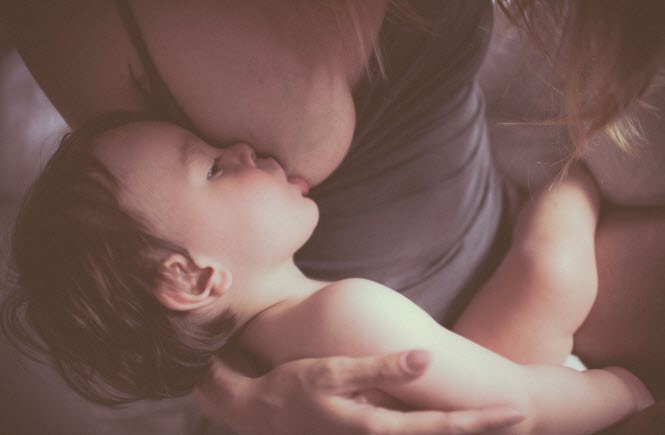
Before diving into how to stop breastfeeding at night, it’s also important to understand why your baby is still seeking your breasts when waking up at night. This behavior is called “comfort nursing” and it means that your child is sucking at your breasts for another purpose besides feeding.
In other words, your baby is finding comfort in sucking at your breasts, similarly to how they could find comfort in a pacifier. This usually increases in frequency when your baby is going through a period of discomfort, such as teething or a growth spur. In fact, breastfeeding is usually one of the best tips to soothe a crying baby.
Your child has also developed a sleep association between nursing and falling asleep, so they can’t go back to sleep by themselves (self-settle) unless they feed. When this happens, you’ll find that they always fall asleep with your nipples still in their mouth.
The reason why I want you to be aware of this is that, as parents, when we reach the point of exhaustion we tend to get quite upset with our babies and expect the impossible in a very short time frame. This tends to happen particularly when babies go through a painful phase (i.e. teething, being sick, etc.) and require more comfort instead of having to undergo rigid sleep training.
So, wherever you are in your breastfeeding journey, if you want to stop breastfeeding your baby at night, remember to be patient and that your little human is just trying to do his/her best with what they know. Adjusting to a new routine and a new reality for them is not easy either.
Related: 18 Tips on How to Soothe a Crying Baby
How to Stop Breastfeeding at Night for 1 Year Old Babies
Once you’ve established that you are ready to stop breastfeeding your 1 year old at night, here’s what you need to do.
1) Give your Baby Time to Self-Settle
All babies (and adults too!) wake up at night, and a brief rousing doesn’t necessarily mean your little one is hungry. They might just be fussing, so give them a chance to settle back in before rushing in to settle / feed them.
Now, if you are reading this post, it probably means you are past this point and your baby’s crying only escalates until you go in. But if not, it’s always worth giving it a try.
I have found this step to be particularly hard with my second daughter, as I was constantly worried she was going to wake her older sister up with all the crying (nobody wants 2 kids crying at night at the same time!).
I do try to let her cry a little bit (2-3 minutes) and see if she self-settles. If not, or if the crying rapidly escalates and she stands in the crib, then I would go in straight away.
I have also learnt pretty soon with my first daughter that if the crying escalates too much, then it also takes much longer to re-settle your baby to sleep.
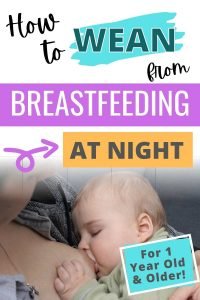
2) Remove Feeding as a Sleep Association
If your baby doesn’t settle back to sleep by themselves, then you need to teach them how to do so without feeding first. You need to remove that sleep association between feeding and falling asleep, and this is when sleep training comes in to play.
Now, there are different sleep training methods that you can use: either the so called “gentle sleep training methods” or the Cry-It-Out method. While the CIO method involves letting your baby cry indefinitely until they fall asleep, the gentle sleep training methods have a more gradual approach and involve little to no crying.
Related: 6 Sleep Training Methods that ACTUALLY work (and that don’t involve Cry It Out!)
Like I mentioned before, I tried the CIO method with my first daughter and I swore I am never going to do it again. I honestly found it to be too hard on both baby and the parents, and only effective in the short term. Instead, I would highly recommend any of the gentle sleep training methods, as these give enough time to all the family members to adapt to the new changes in habits and routines.
I am also a strong believer that no gentle sleep training method is better than the other. I think they can all work and you need to be the one to choose which one will work best for you and your baby. Remember that we all have different personalities (babies included) and what works for one family might not work for another.
The Kim West’s Sleep Lady Shuffle Method
I personally found the Kim West’s Sleep Lady Shuffle method to work best with my daughter when wanting to stop breastfeeding at night.
This is a variation of the Chair, or Sleep Lady Shuffle Sleep Training Method, which consists in a parent sitting in a chair near the crib until their baby falls asleep. Gradually, the parent moves farther and farther away from the crib until they are right outside the door. Eventually, they will no longer need the chair at all.
You are not supposed to give your baby attention: the reason you are in the chair is only to reassure them that you are there with them.
The Kim’s West’s Sleep Lady Shuffle method, on the other hand, lets you attend to your baby periodically, verbally and/or physically and then you can go back to your chair. I like the fact that I could pat my daughter or or chant the sound “om”, util she learned to self-settle. Also, I couldn’t fit a chair in her room, so I just sat on the floor or stood by the side of the crib and gradually moved away.
If you want to try this method, I would recommend doing the following:
- The first few days: attend to your baby as much as needed, including picking them up and rocking them if needed, and sit by the side of the crib.
- Second stage: once your baby can settle easily without you picking them up, slowly reduce the amount of patting or shushing until they can settle without any physical cues (no patting or stroking at all). Still sit by the side of the crib.
- Last stage: move further and further away from the crib every night and, if your child gets upset, you can attend to them again until they settle. Continue until you don’t need to settle your baby anymore and you can just leave them to self-settle by themselves in the room.
Each stage doesn’t have a specific time frame: just follow your baby’s cues and your intuition. Some babies take days, some take a few weeks.
3) Go Slowly
Make sure not to cut off all night feeds at once! This would be very hard for your baby to adapt to, plus it can lead to engorged breasts or it can cause your milk supply to drop.
Instead, go slowly and focus on dropping just one feed at the time. I would recommend stretching out the time between feedings, so that your baby can adapt to going without a feed for longer periods.
I used to feed my daughter around 11 pm, then 2-3 am, then again at 5-6 am. I started by cutting the 11 pm feed, then the 2 am one, and finally, when she was sleeping fine until 5 am, I even dropped the 5 am feed.
Once I dropped the 5 am feed, she was even fine without having a morning feed at 7 am. That said, most babies still go on having a feed at night and a feed in the morning until they are about 18 months old.
Some people recommend shortening the feeding sessions by a few minutes per night instead of stretching the time between feedings. However, I found that to be too hard with my daughter. Once I gave her the boob that was it: she was getting too upset if I was taking it off her before she finished her comfort nursing.
Again, try one method and, if you see that it doesn’t work, give the other method a go. We are all different and no one solution works for everybody!
4) Be Consistent
Night weaning is an adjustment for your baby, and they’ll learn the new routine faster if you have a plan and stick with it rather than offering a feed some nights but not others.
The same goes when you are transitioning your baby from a bassinet to a crib … Be consistent and, no matter how hard and tiring it can get some nights, think of the light at the end of the tunnel! You got this mama!
5) Be Patient
I said it before and I will say it again: remember to be patient. Your baby needs time to adjust to the new routine and some babies take longer than others.
I know it’s very hard sometimes not to get upset, particularly if you reach the limit of exhaustion. If you feel like you can’t do it anymore, I would suggest you swap with your partner so that you can give each other breaks.

How Long will it take to Stop Nursing my 1 Year Old at Night?
The amount of time that it will take you to stop breastfeeding your 1 year old baby at night really depends on different factors, including:
- Your child’s temperament: some babies are more strong-willed than others, or suffer from separation anxiety, so will take longer to learn to self-settle and go back to sleep without a feed in between sleep cycles.
- How often you were feeding your child before you started sleep training: the more your child is used to waking up and feeding at night, the longer it will take to cut all the feeds.
- How strong their sleep association with nursing is: my daughter, for example, was already used to falling asleep by herself when going to bed at 7 pm, so the sleep association was only in the middle of the night. If your child is also used to falling asleep at the breast during the day or for the last feed of the day, it may take longer to teach them how to fall asleep by themselves without a feed.
With the Kim West’s Sleep Lady Shuffle method I described above and, considering that my daughter used to feed 2-3 times a night when I started sleep training, and that she is very stubborn and demanding when she wants something, it took 3-4 weeks to drop all night feeds.
Other Things to Consider When Weaning Off Breastfeeding at Night
What’s important to understand is also that sleep training and dropping all night feeds needs to be a holistic method. You need to consider multiple things, not just focus on the feeding. For example, you also need to look at your child’s day naps, whether your baby is teething or going through some significant developmental changes, etc.
1) Other Sleep Associations
When settling your baby back to sleep, you might be tempted to start rocking or shushing your baby back to sleep. This is fine, particularly the first few times you are trying to cut the milk feed. However, be careful not to create other sleep associations!
If you do it too consistently, then your baby will start associating the rocking or shushing to falling asleep instead of feeding. So, they might not feed at night anymore, but you’ll end up having to get up every time they wake up to settle them.
If your child is struggling to self-settle, you can try other types of sleep associations that don’t involve you, such as:
- A relaxing bedtime routine: you can try a bath, a massage, a book or a song, for example. The more consistent you are with this routine, the easier it will be for your baby to associate it with sleep.
- A white noise machine: this will create a comfortable environment that calms the baby, helping them to fall asleep faster. I used the Hushh Portable White Noise Machine, which is awesome: I could also take it with me in the car or in the stroller.
- A teddy or something that your baby can cuddle with: just make sure it doesn’t create any suffocation hazard!
2) Nap transitions
You have probably already gone through at least another sleep regression (4 month, 6 month or 8 month sleep regression), so don’t be surprised there’s also a 12 months sleep regression!
In fact, between 12 and 15 months your child goes through a big nap transition by dropping the morning nap. This can cause a period of adjustment for your baby, who will usually start waking earlier in the morning or more often at night.
This sleep regression should resolve itself in a few days / weeks, but if you start feeding them back to sleep every time they wake up, you might be in for quite a few night feeds. Plus, you will create a new sleep association that will be hard to stop and that you will need to get rid of.
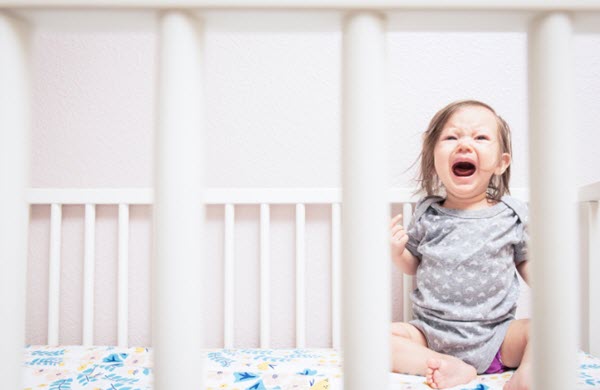
3) Day Routine
Babies that sleep too much during the day, may wake up at night because they are not tired enough. The same happens if they are overtired, because the stress hormone builds up and wakes them in between sleep cycles.
A good night sleep starts with a good routine and nap(s) during the day!
At 12 months, if your baby is still having a morning nap, they should still be sleeping between 9.30 and 10 am. However, if they start resisting this nap, it means they are ready to transition to just one nap after lunch time: usually between 12.30 and 2.30 (or 3) pm.
Here’s a guide of what a good routine for a 1 year old looks like:
6 / 7 am Wake Up
7.30 am Breakfast with milk feed
9.30 am Morning Nap (10-15 min) if needed (30 min max)
10 am Morning tea
11.45 am Lunch
12 / 12.30 pm Lunch nap (2 – 2 1/2 hours)
3 pm Afternoon tea
5 pm Dinner
6 pm Bath
6.45 pm Milk feed
7 pm Bedtime
However, remember that every baby is different. Some drop the morning nap earlier than others, some still have a milk feed during the day and others don’t, etc.
Also, family routines are different and not all families can stick to a strict routine as shown above, myself included. Now that I have two kids, I find it particularly hard to have dinner before 6.15 pm for example! So, my daughter has her bath before dinner and doesn’t go to bed until 7.15 / 7.30 pm.
Plus, my second daughter was very happy to drop all her feeds during the day by 1 year old. She dropped the afternoon feed at 12 months, and the morning feed at 13 months.
Do what feels right for your baby and your family! But, as a general guideline, make sure that they have a very good sleep in the afternoon (at least 2 hours): this will really help with getting to bed at night without being overtired.
4) Teething
Teeth in babies usually start to emerge between 6 and 12 months, and the pain behind it might wake your baby up at night.
Look out for signs of teething and, if that’s the case, I found applying some teething powder on the gums before bedtime to be very helpful in reducing pain.
5) Sickness
This might seem a bit of a given, but remember that babies don’t sleep well when they are sick. It can be hard, particularly if you are in the middle of sleep training, to stop what you are doing and break the routine.
I really wouldn’t recommend sleep training (including weaning off from breastfeeding) while your baby is sick.
6) Separation Anxiety
Separation anxiety in babies can start any time after 6 months, and you will find that a baby that was always OK to sleep in their own room, will start being upset all alone in their crib at night.
Again, like for some of the reasons above, don’t just start feeding them so they go back to sleep! This will create a new sleep association that you will need to get rid of.
7) Dummy / Pacifier
Many babies who use a pacifier wake up when it falls out of their mouth, and you will need to be the one putting it back in their mouth. If that is the case for your child and you want to get rid of the pacifier, make sure not to start feeding your child to sleep instead. Otherwise you will replace the sleep association to the pacifier with a sleep association to your breast.
My first daughter had that problem with the pacifier and what we found to really help was leaving an extra 2 pacifiers in the crib. By 12 months she was old enough to understand that if she lost one, she could look for another one around her in the crib.
We then waited to get rid of the pacifier until she was about 2.5 years old able to rationalize it a bit better.
Related: 18 Pacifier Alternatives (for Babies & Toddlers!)
8) Dream Feed
Some people suggest doing a dream feed before you go to sleep and while your child is still sleeping. This way, your child gets a fully tummy and is more likely to sleep through the night.
I personally wouldn’t recommend a dream feed for a 1 year old though: babies this age are already old enough to sleep through the night without a feed. Also, I find them to be too aware, and picking them up without waking them becomes quite hard.
That said, every baby and every family is different and, like the Baby Sleep Site says: if it works for your you and your baby, then there’s no reason why you shouldn’t do it.
9) Partner Involvement
If you have a dad or partner that can and wants to be involved in helping you out at night, take the offer! Other than the fact that it’s good to take turns at settling your baby so that you can have a bit of a rest, babies also react differently to someone that doesn’t have milk in their breasts 🙂
We found that my wife could settle my daughter way easier, particularly the first times that we tried to cut the milk feeds at night.
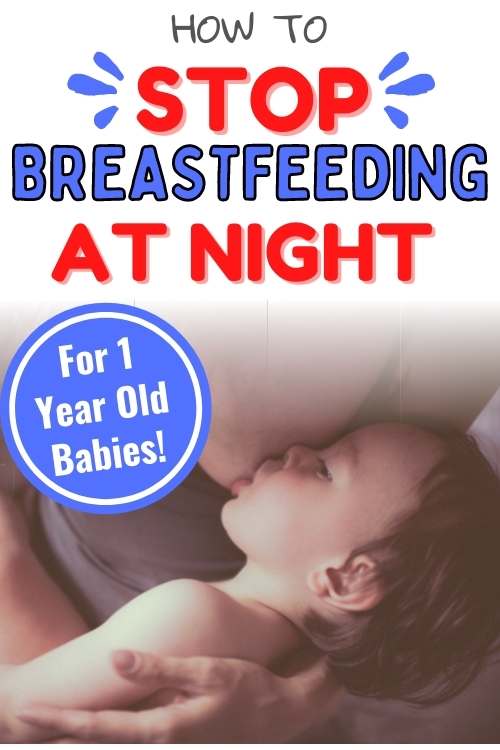
Tips to Help your Toddler Sleep Better at Night
Here’s some other tips on how to help your 1 year old sleep better at night:
1) Have a Good Bedtime Routine
If your baby loves all the social interaction before going to bed and is very excited when you put them down at night, they will struggle to fall asleep and might wake up at night. You need to help them wind down by removing them from the exciting environment and create a calm sleep routine.
Like I mentioned above, you can try a bath, a massage, a book or a song. Any of these will become a positive new sleep association.
Be aware of baths though: some moms find a bath to be too stimulating for their baby just before going to sleep, particularly with a 1 year old. While it can be calming for a newborn, it can become a good opportunity to play some more and get excited for an older baby.
I personally could never rely on a bath to calm my daughters down at that age!
2) Dark Room
Make sure that the room where your 1 year old is sleeping is dark: dark promotes the release of melatonin, which is a hormone crucial to your baby settling and sleeping well.
This is particularly true during summer (depending on where you live), when the sun comes up before 6! You definitely don’t want your baby to wake up at 5.30 am because light is coming from the window.
3) Do Not Change Diapers
Try not to change your baby’s diaper in the middle of the night. Unless your baby had a diaper blowout (which probably means your baby is sick at this age!), then skip middle-of-the-night changes. These will only wake your baby up, and it will make it harder to put them back to sleep.
4) Dress Baby Appropriately
Babies can also wake up if they are too hot or too cold, so make sure that they are dressed appropriately depending on the room temperature. Use a heater or a fan to bring the room temperature to an optimal if you can.
You can find more information on how to dress your baby to sleep and how to regulate the room temperature here.
At this age I would highly recommend having your baby sleep in a sleep sack: this allows their arms to be free and for them to move around easily without getting cold. Once they are older (usually 2 years old) and they can put the blanket back on by themselves, then you can transition them to a blanket / duvet.

5) Move Baby to they own Room
If your baby is still sleeping in your room at 1 year old and they start standing up in the crib and crying because they see you, I highly recommend moving your baby to their own room.
This is what we had to do with our second daughter: even though I loved having her in our room, it was becoming to hard to settle her back to sleep in her crib (or even in bed with us!). Moving her into her own room solved this straight away for some reason! I think the fact that she could see us in bed was making it way worse.
6) Get Professional Help
If you are still struggling with sleep training and weaning your baby off breastfeeding at night, then I would highly recommend reaching our to a sleep consultant. And the reason why I think it’s important to reach out if needed is because a sleep consultant can really look at your (and your baby’s) specific needs and tailor their program to meet your individual requirements.
If you want to investigate this idea further, here’s some links to some sleep training programs that offer gentle and personalized sleep plans for your baby’s needs:
- The Baby Sleep Site: they have packages that start at $139 and group options for as little as $69. They also have some great FREE resources <- here.
- Sleep Sense: They have packages for as little as $49, and also offer a FREE Sleep Assessment <- here
- The Sleep Lady Team: focused on the Sleep Lady Shuffle method, it offers two different courses for $149, one for children in cribs (up to 2.5 years old), and one for children in their own bed (up to 6 years old).
- Baby Sleep Made Simple: it offers packages for less than $100, with the choice of do-it-yourself or personal support packages. It also offers a FREE Exhausted Mom’s Starter Kit and a FREE Sleep Regression Survival Guide.
How to Stop Breastfeeding a 1 Year Old at Night: Final Thoughts
Weaning my daughter off breastfeeding at night and sleep training was definitely the best thing I did, for her and for me. She went for nursing 2-3 times a night from no feeding at all in just a few weeks!
It was quite hard during those 3-4 weeks, and the exhaustion got worse before it got better. But it was all worth it, and now that we are all having a better sleep at night, we are all happier and with much more energy!
If you are struggling with feeding your 1 year old a lot at night, I highly encourage you to try the same sleep training method I used and described above, or have a look at these other gentle sleep training methods. These really help your child transition from a waking up a lot at night to sleeping through without letting them cry for too long.
And remember to be calm, patient and consistent! 🙂
Are you a mom that’s stopped breastfeeding your 1 year old at night and have more tips to share? Or are you going though the process and have more questions?
Either way, feel free to share your thoughts and ask questions in the comments below. I’d love to hear from you!
Did you find this useful? Pin It!
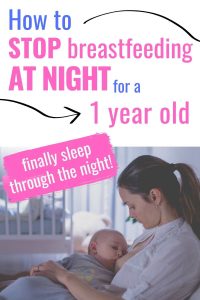

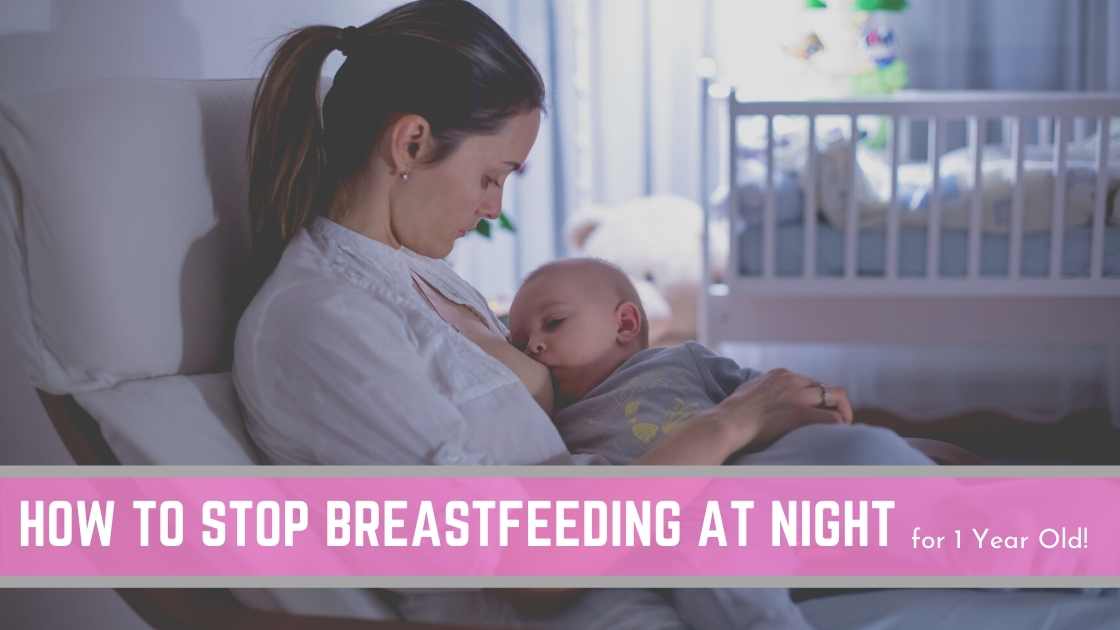
This was a really interesting read and thanks so much for sharing.
Theese are great tips for moms who are ready to stop breastfeeding. A good read if you want to do it right and when your baby is ready as well
thanks Tshire 🙂 absolutely, do it when baby is ready!
Great tips! Definitely something for Momma’s to think about.
Once I night weaned, my boys slept through the night. One was 18 months, and I was like “this was all I needed to do?”. The next was a year old, when I finally decided to. He went from every 2 hours to sleeping 10-12 hours (was actually 13 the other day!).
That was very beneficial thank you.
my kids thankfully slept longer hours by the time they turned a year old.. so i did not have to wake up to feed them, but i do recall a few phases when they had turned to the comfort feeding mode you mention.
all your tips are definitely going to help moms who are trying to night wean their babies
A great post i am saving for when I welcome my little one this summer.
Thanks Penny! If you are still pregnant, I would suggest you also look at my post on how to tickle the 4 month sleep regression! If you get that one right, it will make sleep training so much easier down the line 🙂
For sleeping through the night I believe it was consistency that helped us most. At some point I’ve seen Zoey is not waking to eat but she just cannot fall back asleep. I’ve been following this book: https://www.parental-love.com/shop/toddler-sleep-training from Susan Urban for some time and it helped.
But thanks for the weaning tips, we’ll be trying it out soon!
Hi Jean, thanks for the feedback and for the suggestion of that book 🙂 Good luck with weaning, let me know if you need any help!